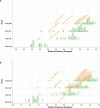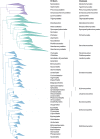A genome-informed higher rank classification of the biotechnologically important fungal subphylum Saccharomycotina
- PMID: 38895705
- PMCID: PMC11182611
- DOI: 10.3114/sim.2023.105.01
A genome-informed higher rank classification of the biotechnologically important fungal subphylum Saccharomycotina
Abstract
The subphylum Saccharomycotina is a lineage in the fungal phylum Ascomycota that exhibits levels of genomic diversity similar to those of plants and animals. The Saccharomycotina consist of more than 1 200 known species currently divided into 16 families, one order, and one class. Species in this subphylum are ecologically and metabolically diverse and include important opportunistic human pathogens, as well as species important in biotechnological applications. Many traits of biotechnological interest are found in closely related species and often restricted to single phylogenetic clades. However, the biotechnological potential of most yeast species remains unexplored. Although the subphylum Saccharomycotina has much higher rates of genome sequence evolution than its sister subphylum, Pezizomycotina, it contains only one class compared to the 16 classes in Pezizomycotina. The third subphylum of Ascomycota, the Taphrinomycotina, consists of six classes and has approximately 10 times fewer species than the Saccharomycotina. These data indicate that the current classification of all these yeasts into a single class and a single order is an underappreciation of their diversity. Our previous genome-scale phylogenetic analyses showed that the Saccharomycotina contains 12 major and robustly supported phylogenetic clades; seven of these are current families (Lipomycetaceae, Trigonopsidaceae, Alloascoideaceae, Pichiaceae, Phaffomycetaceae, Saccharomycodaceae, and Saccharomycetaceae), one comprises two current families (Dipodascaceae and Trichomonascaceae), one represents the genus Sporopachydermia, and three represent lineages that differ in their translation of the CUG codon (CUG-Ala, CUG-Ser1, and CUG-Ser2). Using these analyses in combination with relative evolutionary divergence and genome content analyses, we propose an updated classification for the Saccharomycotina, including seven classes and 12 orders that can be diagnosed by genome content. This updated classification is consistent with the high levels of genomic diversity within this subphylum and is necessary to make the higher rank classification of the Saccharomycotina more comparable to that of other fungi, as well as to communicate efficiently on lineages that are not yet formally named. Taxonomic novelties: New classes: Alloascoideomycetes M. Groenew., Hittinger, Opulente & A. Rokas, Dipodascomycetes M. Groenew., Hittinger, Opulente & A. Rokas, Lipomycetes M. Groenew., Hittinger, Opulente, A. Rokas, Pichiomycetes M. Groenew., Hittinger, Opulente & A. Rokas, Sporopachydermiomycetes M. Groenew., Hittinger, Opulente & A. Rokas, Trigonopsidomycetes M. Groenew., Hittinger, Opulente & A. Rokas. New orders: Alloascoideomycetes: Alloascoideales M. Groenew., Hittinger, Opulente & A. Rokas; Dipodascomycetes: Dipodascales M. Groenew., Hittinger, Opulente & A. Rokas; Lipomycetes: Lipomycetales M. Groenew., Hittinger, Opulente & A. Rokas; Pichiomycetes: Alaninales M. Groenew., Hittinger, Opulente & A. Rokas, Pichiales M. Groenew., Hittinger, Opulente & A. Rokas, Serinales M. Groenew., Hittinger, Opulente & A. Rokas; Saccharomycetes: Phaffomycetales M. Groenew., Hittinger, Opulente & A. Rokas, Saccharomycodales M. Groenew., Hittinger, Opulente & A. Rokas; Sporopachydermiomycetes: Sporopachydermiales M. Groenew., Hittinger, Opulente & A. Rokas; Trigonopsidomycetes: Trigonopsidales M. Groenew., Hittinger, Opulente & A. Rokas. New families: Alaninales: Pachysolenaceae M. Groenew., Hittinger, Opulente & A. Rokas; Pichiales: Pichiaceae M. Groenew., Hittinger, Opulente & A. Rokas; Sporopachydermiales: Sporopachydermiaceae M. Groenew., Hittinger, Opulente & A. Rokas. Citation: Groenewald M, Hittinger CT, Bensch K, Opulente DA, Shen X-X, Li Y, Liu C, LaBella AL, Zhou X, Limtong S, Jindamorakot S, Gonçalves P, Robert V, Wolfe KH, Rosa CA, Boekhout T, Čadež N, Péter G, Sampaio JP, Lachance M-A, Yurkov AM, Daniel H-M, Takashima M, Boundy-Mills K, Libkind D, Aoki K, Sugita T, Rokas A (2023). A genome-informed higher rank classification of the biotechnologically important fungal subphylum Saccharomycotina. Studies in Mycology 105: 1-22. doi: 10.3114/sim.2023.105.01 This study is dedicated to the memory of Cletus P. Kurtzman (1938-2017), a pioneer of yeast taxonomy.
Keywords: Higher rank classification; Saccharomycotina; novel taxa; orthologous groups (OGs); taxonomy; yeasts.
© 2023 Westerdijk Fungal Biodiversity Institute.
Conflict of interest statement
Antonis Rokas is a scientific consultant for LifeMine Therapeutics, Inc.
Figures


Similar articles
-
Towards an integrated phylogenetic classification of the Tremellomycetes.Stud Mycol. 2015 Jun;81:85-147. doi: 10.1016/j.simyco.2015.12.001. Epub 2016 Jan 8. Stud Mycol. 2015. PMID: 26955199 Free PMC article.
-
Diversity and phylogeny of basidiomycetous yeasts from plant leaves and soil: Proposal of two new orders, three new families, eight new genera and one hundred and seven new species.Stud Mycol. 2020 Jan 28;96:17-140. doi: 10.1016/j.simyco.2020.01.002. eCollection 2020 Jun. Stud Mycol. 2020. PMID: 32206137 Free PMC article.
-
Phylogenetic classification of yeasts and related taxa within Pucciniomycotina.Stud Mycol. 2015 Jun;81:149-89. doi: 10.1016/j.simyco.2015.12.002. Epub 2016 Jan 11. Stud Mycol. 2015. PMID: 26951631 Free PMC article.
-
Evolution of Mating in the Saccharomycotina.Annu Rev Microbiol. 2017 Sep 8;71:197-214. doi: 10.1146/annurev-micro-090816-093403. Epub 2017 Jun 28. Annu Rev Microbiol. 2017. PMID: 28657889 Review.
-
Natural trait variation across Saccharomycotina species.FEMS Yeast Res. 2024 Jan 9;24:foae002. doi: 10.1093/femsyr/foae002. FEMS Yeast Res. 2024. PMID: 38218591 Free PMC article. Review.
Cited by
-
Phylogenomic analysis of the Candida auris-Candida haemuli clade and related taxa in the Metschnikowiaceae, and proposal of thirteen new genera, fifty-five new combinations and nine new species.Persoonia. 2024 Aug;52:22-43. doi: 10.3767/persoonia.2024.52.02. Epub 2024 Apr 6. Persoonia. 2024. PMID: 39161632 Free PMC article.
-
Unique trajectory of gene family evolution from genomic analysis of nearly all known species in an ancient yeast lineage.bioRxiv [Preprint]. 2024 Jun 6:2024.06.05.597512. doi: 10.1101/2024.06.05.597512. bioRxiv. 2024. Update in: Mol Syst Biol. 2025 Aug;21(8):1066-1089. doi: 10.1038/s44320-025-00118-0. PMID: 38895429 Free PMC article. Updated. Preprint.
-
Stable hypermutators revealed by the genomic landscape of DNA repair genes among yeast species.bioRxiv [Preprint]. 2025 Mar 17:2025.03.15.643480. doi: 10.1101/2025.03.15.643480. bioRxiv. 2025. PMID: 40166188 Free PMC article. Preprint.
-
Functional and evolutionary integration of a fungal gene with a bacterial operon.bioRxiv [Preprint]. 2023 Nov 21:2023.11.21.568075. doi: 10.1101/2023.11.21.568075. bioRxiv. 2023. Update in: Mol Biol Evol. 2024 Apr 2;41(4):msae045. doi: 10.1093/molbev/msae045. PMID: 38045280 Free PMC article. Updated. Preprint.
-
Yeast sexes: mating types do not determine the sexes in Metschnikowia species.FEMS Yeast Res. 2024 Jan 9;24:foae014. doi: 10.1093/femsyr/foae014. FEMS Yeast Res. 2024. PMID: 38632043 Free PMC article.
References
-
- Abbas C. (2003). Emerging biorefineries and biotechnological applications of nonconventional yeast: now and in the future. The alcohol textbook, 4th edn. Nottingham University Press, Nottingham, UK: 171–191.
-
- Boontham W, Angchuan J, Boonmak C, et al. (2020). Limtongozyma siamensis gen. nov., sp. nov., a yeast species in the Saccharomycetales and reassignment of Candida cylindracea to the genus Limtongozyma. International Journal of Systematic and Evolutionary Microbiology 70: 199–203. - PubMed
Associated data
Grants and funding
LinkOut - more resources
Full Text Sources
